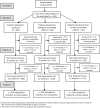High intensity smoking cessation interventions: Cardiac patients of low socioeconomic status and low intention to quit profit most
- PMID: 27752966
- PMCID: PMC5179363
- DOI: 10.1007/s12471-016-0906-7
High intensity smoking cessation interventions: Cardiac patients of low socioeconomic status and low intention to quit profit most
Abstract
Background: Without assistance, smokers being admitted to the hospital for coronary heart disease often return to regular smoking within a year.
Objective: This study assessed the 12-month effectiveness of a telephone and a face-to-face counselling intervention on smoking abstinence among cardiac patients. Differential effects for subgroups varying in their socioeconomic status and intention to quit smoking were also studied.
Methods: A randomised controlled trial was used. During hospital stay, smokers hospitalised for coronary heart disease were assigned to usual care (n = 245), telephone counselling (n = 223) or face-to-face counselling (n = 157). Eligible patients were allocated to an intervention counselling group and received nicotine patches. After 12 months, self-reported continued abstinence was assessed and biochemically verified in quitters. Effects on smoking abstinence were tested using multilevel logistic regression analyses applying the intention-to-treat approach.
Results: Compared with usual care, differential effects of telephone and face-to-face counselling on continued abstinence were found in patients with a low socioeconomic status and in patients with a low quit intention. For these patients, telephone counselling increased the likelihood of abstinence threefold (OR = 3.10, 95 % CI 1.32-7.31, p = 0.01), whereas face-to-face counselling increased this likelihood fivefold (OR = 5.30, 95 % CI 2.13-13.17, p < 0.001). Considering the total sample, the interventions did not result in stronger effects than usual care.
Conclusion: Post-discharge telephone and face-to-face counselling interventions increased smoking abstinence rates at 12 months compared with usual care among cardiac patients of low socioeconomic status and low quit intentions. The present study indicates that patients of high socioeconomic status and high quit motivation require different cessation approaches.
Keywords: Coronary heart disease; Face-to-face counselling; Intention to quit; Smoking cessation; Socioeconomic status; Telephone counselling.
Conflict of interest statement
Conflict of interestN. Berndt, H. de Vries, L. Lechner, F. Van Acker, E. S. Froelicher, F. Verheugt, A. Mudde and C. Bolman state that they have no competing interest.
Figures


References
-
- Shah AM, Pfeffer MA, Hartley LH, et al. Risk of all-cause mortality, recurrent myocardial infarction, and heart failure hospitalization associated with smoking status following myocardial infarction with left ventricular dysfunction. Am J Cardiol. 2010;106:911–916. doi: 10.1016/j.amjcard.2010.05.021. - DOI - PubMed
LinkOut - more resources
Full Text Sources
Other Literature Sources

